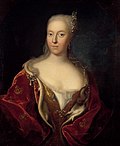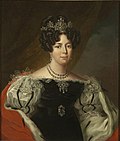| Picture | Name | Father | Birth | Marriage | Became Consort | Ceased to be Consort | Death | Spouse |
|---|
 | Dorothea of Brandenburg
[8] [9] [3] [4] [10] [12] [13] | John, Margrave of Brandenburg-Kulmbach
(Hohenzollern) | 1430–31 | 28 October 1449 | June 1450
husband's accession | 21 May 1481
husband's death | 10 November 1495 | Christian I |
| Interregnum (1481–1483) |
 | Christina of Saxony
[8] [9] [3] [4] [10] [12] | Ernest, Elector of Saxony
(Wettin) | 25 December 1461 | 6 September 1478 | 1483
husband's accession | 20 February 1513
husband's death | 8 December 1521 | John |
 | Isabella of Austria
[8] [9] [3] [4] [10] [12] | Philip I of Castile
(Habsburg) | 18 July 1501 | 12 August 1515 | 20 January 1523
husband's deposition | 19 January 1526 | Christian II |
 | Sophie of Pomerania
[8] [9] [3] [10] [12] | Bogislaw X, Duke of Pomerania
(Pomerania) | 1498 | 9 October 1518 | 1524
husband's accession | 10 April 1533
husband's death | 13 May 1568 | Frederick I |
| Interregnum (1533–1537) |
 | Dorothea of Saxe-Lauenburg
[8] [9] [3] [10] [12] | Magnus I, Duke of Saxe-Lauenburg
(Ascania) | 9 July 1511 | 29 October 1525 | 1537
husband's accession | 1 January 1559
husband's death | 7 October 1571 | Christian III |
 | Sophie of Mecklenburg-Güstrow
[8] [9] [3] [10] [12] | Ulrich III, Duke of Mecklenburg-Güstrow
(Mecklenburg-Güstrow) | 4 September 1557 | 20 July 1572 | 4 April 1588
husband's death | 14 October 1631 | Frederick II |
 | Anne Catherine of Brandenburg
[8] [9] [3] [10] [12] | Joachim III Frederick, Elector of Brandenburg
(Hohenzollern) | 26 June 1575 | 27 November 1597 | 8 April 1612 | Christian IV |
 | Sophie Amalie of Brunswick-Lüneburg
[8] [9] [3] [10] [12] | George, Duke of Brunswick-Lüneburg
(Welf) | 24 March 1628 | 1 October 1643 | 6 July 1648
husband's accession | 9 February 1670
husband's death | 20 February 1685 | Frederick III |
 | Charlotte Amalie of Hesse-Kassel
[8] [9] [3] [10] [12] | William VI, Landgrave of Hesse-Kassel
(Hesse-Kassel) | 27 April 1650 | 25 June 1667 | 9 February 1670
husband's accession | 25 August 1699
husband's death | 27 March 1714 | Christian V |
 | Louise of Mecklenburg-Güstrow
[8] [9] [3] [10] [12] | Gustav Adolf, Duke of Mecklenburg-Güstrow
(Mecklenburg-Güstrow) | 28 August 1667 | 5 December 1695 | 25 August 1699
husband's accession | 15 March 1721 | Frederick IV |
 | Anne Sophie Reventlow
[8] [9] [3] [10] [12] | Conrad, Count Reventlow
(Reventlow) | 16 April 1693 | 4 April 1721 | 12 October 1730
husband's death | 7 January 1743 |
 | Sophia Magdalene of Brandenburg-Kulmbach
[8] [9] [3] [10] [12] | Christian Heinrich, Margrave of Brandenburg-Bayreuth-Kulmbach
(Hohenzollern) | 28 November 1700 | 7 August 1721 | 12 October 1730
husband's accession | 6 August 1746
husband's death | 27 May 1770 | Christian VI |
 | Louise of Great Britain
[8] [9] [3] [10] [12] | George II of Great Britain
(Hanover) | 7 December 1724 | 11 December 1743 | 6 August 1746
husband's accession | 19 December 1751 | Frederick V |
 | Juliana Maria of Brunswick-Wolfenbüttel
[8] [9] [3] [10] [12] | Ferdinand Albert II, Duke of Brunswick-Wolfenbüttel
(Brunswick-Bevern) | 4 September 1729 | 8 July 1752 | 13 January 1766
husband's death | 10 October 1796 |
 | Caroline Matilda of Great Britain
[8] [9] [3] [10] [12] | Frederick, Prince of Wales
(Hanover) | 11 July 1751 | 8 November 1766 | 10 May 1775 | Christian VII |
 | Marie Sophie of Hesse-Kassel
[8] [9] [3] [10] [12] [14] | Landgrave Charles of Hesse-Kassel
(Hesse-Kassel) | 28 October 1767 | 31 July 1790 | 13 March 1808
husband's accession | 14 January 1814
husband's deposition | 22 March 1852 | Frederick VI |
|











































